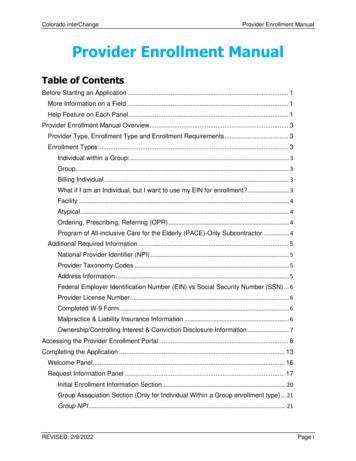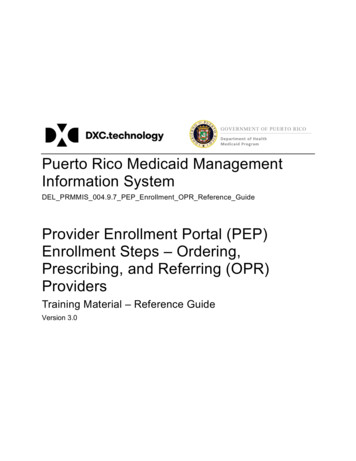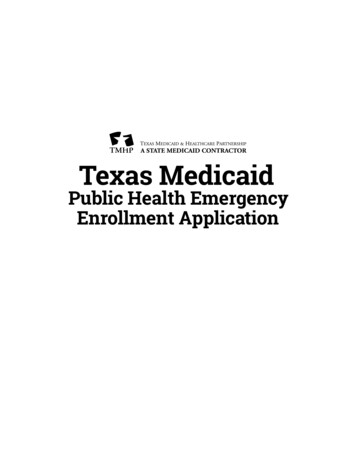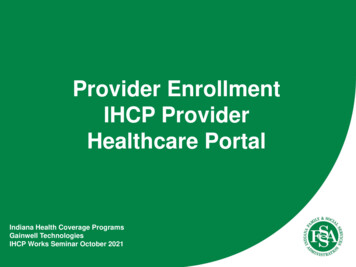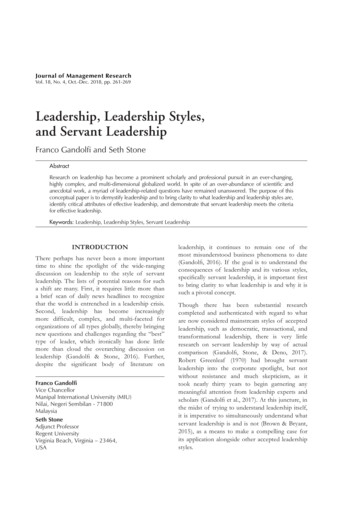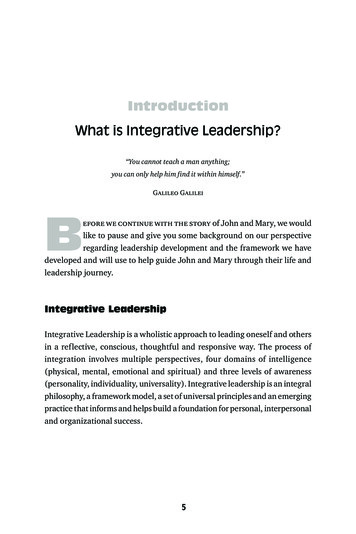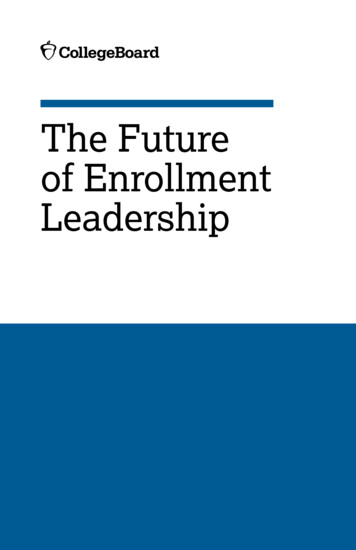
Transcription
The Futureof EnrollmentLeadership
Contents171519314151PrefaceIntroduction:Setting the Stage: Context and ChallengesChapter 1:Capacities Inherent in Enrollment LeadersChapter 2:Data and AnalysisChapter 3:Economic Leadership in Higher EducationChapter 4:Admissions Risks and OpportunitiesChapter 5:Student Success65Conclusion and Next Steps:The Ongoing Centrality of Enrollment Leadershipin the Evolution of Higher Education69Acknowledgments
PrefaceThe work of enrollment leaders has always been shaped by challengesand opportunities facing higher education and our own institutions. Newchallenges and opportunities for higher education create new roles forenrollment leaders.The higher education sector is seeing a growth in public skepticism aboutthe value of a college degree; a decline in college student populations;challenges to using race in admissions; decreasing public funding; andincreasing costs and student debt. At the same time, we have more dataand information at our fingertips and better technology than ever before,as well as greater opportunities for collaboration and innovation withcolleagues at our institutions and across the country.All of these factors mean that enrollment leadership is changing. On agrowing number of campuses, the role of enrollment leaders is expandingits reach and influence beyond the traditional enrollment structures ofadmissions, financial aid, and registration. They are increasingly calledupon to shape strategy across an institution, while still needing to meetenrollment, retention, and graduation objectives.In June 2018, the College Board assembled 31 enrollment leaders at itsheadquarters to consider the future of enrollment leadership over thenext 15 years, and to imagine the roles they must play so their institutionsand students—and higher education—can thrive.Enrollment leaders led robust group discussions focused on the skillssuccessful enrollment leaders bring to new and expanding roles on campus.James M. MontoyaChief of Membership, Governance,and Global Higher Education,Secretary of the CorporationThe College BoardMartha PittsExecutive Director,Higher Education StrategicPartnerships and InitiativesThe College Board1
What This Monograph IsRather than reexploring the field of enrollment management, the focus ofthe monograph is the work of enrollment leaders who must have specificskills and capacities to be successful in traditional roles, who will addressnew challenges, and who will take advantage of new opportunities. Thismonograph sets forth key takeaways from our discussion, particularly theroles enrollment leaders will need to fill, including:§ Shaping how our institutions think, act, and evolve;§ Leading strategic conversations;§ Identifying new models and structures;§ Implementing the visions of presidents, trustees, and other seniorleaders; and§ Increasing student success.It reflects on and draws from current research and resources that help usframe how enrollment leaders can approach the most pressing challengesfacing higher education institutions.What This Monograph Is NotThis document isn’t intended to be a record of meeting proceedings ora chronological presentation of our wide-ranging discussions. It doesn’tprovide an exhaustive list of enrollment leaders’ competencies, skills,and areas of expertise or cover the details of organizational structuresor reporting lines. If you’re looking for best practices in those areas,organizations like the American Association of Collegiate Registrars andAdmissions Officers (AACRAO) and the Center for Enrollment Research,Policy and Practice (CERPP) have many resources available on theirwebsites. Another resource is the Handbook of Strategic EnrollmentManagement by Don Hossler and Bob Bontrager, which covers theadministrative function of enrollment management.2
How the Monograph Is OrganizedThe monograph is organized by major topic, beginning with an Introductionthat lays out the broad social and economic trends that impact bothhigher education and the role of the enrollment leader. In Chapter 1, thecrosscutting skills that enrollment leaders uniquely bring to the institutionare identified.Chapters 2–5 cover key topics in enrollment leadership: data and analysis,the economic model, admissions, and student success. In each chapter,the roles enrollment leaders play are identified, and then the contextand history that brought us to where we are today—key considerations,best practices, and examples of leadership in action—are provided.Each chapter concludes with a set of forward-looking questions. Themonograph ends with a conclusion describing the ongoing centrality of theenrollment leader.Enrollment management is a relatively young field, and it is alreadyevolving significantly. We hope this monograph can encourage and informthoughtful conversations about the future of this field.3
Enrollment Leadership Summit Participants*John BarnhillAssistant Vice Presidentfor Enrollment ManagementFlorida State UniversityKedra IshopVice Provost for EnrollmentManagementUniversity of MichiganClark BriggerAssistant Vice President forUndergraduate EducationPennsylvania State University,University ParkIngrid HayesVice President for EnrollmentManagementSpelman CollegeAdele BrumfieldAssociate Vice Chancellor forEnrollment ManagementUniversity of California San DiegoRachelle HernandezSenior Vice Provost forEnrollment ManagementUniversity of Texas at AustinTimothy BrunoldDean of AdmissionsUniversity of Southern CaliforniaKent HopkinsVice President forEnrollment ServicesArizona State UniversityDouglas L. ChristiansenVice Provost for UniversityEnrollment AffairsVanderbilt UniversityDavid JohnsonVice Provost Office ofEnrollment ManagementIndiana University BloomingtonJim CotterDirector of AdmissionsMichigan State UniversityMichael KabbazSenior Vice Presidentfor Enrollment Managementand Student SuccessMiami University at OxfordShannon GundyDirector ofUndergraduate AdmissionsUniversity of MarylandChristoph GuttentagDean of UndergraduateAdmissionsDuke University4Paul KohnVice Provost forEnrollment ServicesGeorgia Institute of Technology
Stacey KostellVice President for EnrollmentManagementUniversity of VermontMatthew LopezAssistant Vice Presidentfor Enrollment ServicesArizona State UniversityJessica MarinaccioDean of UndergraduateAdmissions and Financial AidColumbia UniversityCourtney McAnuffVice President forEnrollment ManagementRutgers UniversityRodney MorrisonAssociate Provost forEnrollment and RetentionManagementState University ofNew York Stony BrookJames NondorfVice President for Enrollmentand Student AdvancementUniversity of ChicagoMildred Rigney JohnsonDean of AdmissionsRadford UniversityGregory RobertsDean of AdmissionUniversity of VirginiaStu SchmillDean of Admissions andStudent Financial ServicesMassachusetts Instituteof TechnologyCarey ThompsonVice President of Enrollmentand CommunicationsRhodes CollegeWes WaggonerAssociate Vice President forEnrollment ManagementSouthern Methodist UniversityJarrid WhitneyExecutive Director ofAdmissions and Financial AidCalifornia Institute of Technology* Note: Titles and institutional affiliations current as of June 2018.5
Session Topics and Discussion LeadersSETTING THE STAGEMartha PittsExecutive Director for HigherEducation Strategic InitiativesThe College BoardRandall C. DeikeSenior Vice President forEnrollment Management andStudent SuccessDrexel UniversityCHALLENGE:THE ECONOMIC MODELYoulonda Copeland–MorganVice Provost for EnrollmentManagementUniversity of Californiaat Los AngelesCHALLENGE:WHAT INFLUENCESWHO GETS ADMITTEDAND WHO ENROLLSYvonne Romero Da SilvaVice President for EnrollmentRice University6CHALLENGE:DATA EXPLOSION: DATA,BIG DATA, AND THESTUDENT LIFE CYCLEJ. Carey ThompsonVice President of Enrollmentand CommunicationsRhodes CollegeCHALLENGE:FOCUS ON STUDENTOUTCOMESMJ Knoll–FinnSenior Vice President forEnrollment ManagementNew York UniversityCENTRALITY OFTHE ROLE OF THEENROLLMENT MANAGERRandall C. DeikeSenior Vice President forEnrollment Managementand Student SuccessDrexel University
INTRODUCTIONSetting the Stage:Context and ChallengesThe Biggest Picture: Broad ForcesThat Are Reshaping Higher EducationOver the last three decades, higher education has faced a series ofeconomic, social, cultural, and political challenges that have impactedthe sector and shaped the emergence and growth of the enrollmentmanagement field. In the last 10 years, many of these forces haveaccelerated the pressures on higher education institutions, exacerbatedfurther by the Great Recession of 2008. In response, some institutions areexperimenting with, and introducing, new programs, outcome measures,and management structures to address the evolving challenges ofrecruiting, enrolling, and graduating students.Globalization, technology, and growing economic inequality are driving thequestions about the role of higher education in society and the economy.As population demographics continue to shift, workforce needs arechanging rapidly. Economic fluctuations and uncertainty continue to createfunding challenges for public and private institutions alike. And with thecontinued growth in the cost of college, the media and the public havebegun to question the value and return on the investment of a collegeeducation. According to the Pew Research Center, 6 in 10 Americans thinkhigher education is going in the wrong direction. Of those, 84% cite hightuition costs, and 65% say students aren’t getting the skills they need tosucceed in the workplace.1In addition, the current political and cultural climate is eroding overall publictrust in institutions generally. The 2018 Edelman Trust Barometer reports:1. Pew Research Center, “Most Americans say higher ed is heading in the wrong direction, butpartisans disagree on why.” (July 21, 2018). ection-but-partisans-disagree-on-why/7
“In a year marked by turbulence at home and abroad, trust in institutionsin the United States crashed, posting the steepest, most dramatic generalpopulation decline the Trust Barometer has ever measured.”2Although the Trust Barometer notes that trust in education to betterthe world remains stronger than trust in 28 of the 30 industries studied,pervasive public distrust shapes nearly every aspect of our work.In facing these challenges, enrollment leaders can either be actors, orthey can be directors who use the skills and abilities required for successin enrollment to provide the vision and strategies necessary for campussuccess. Each campus and each enrollment leader must decide how toaddress these challenges and consider questions, including:§ How do I prepare to lead across campus, contribute to successstrategies, and build toward the vision of my president or chancellor?§ How can I shape and frame the conversations on campus, rather thansimply participate?Key Challenges for Higher Education—and Opportunities for Enrollment LeadersEnrollment leaders appreciate that the fortunes of their institutions will riseand fall depending on their skill in calibrating this bottom line in responseto market forces. New communications technologies, stringent costmodels, dynamic student demographics, and shifting political and publicperceptions about the value of higher education will impact colleges anduniversities everywhere.These dynamic changes—which include a greater emphasis on collegecompletion and more explicit calculations regarding the economic valueof a college degree—place institutions’ admissions policies and practicesat the center of a national conversation about college admission, collegereadiness, and college completion.2. Edelman. “Edelman Trust Barometer,” January 21, 2018.https://www.edelman.com/trust-barometer8
Of the broad forces challenging higher education, enrollment leadersidentified three that have the most direct relevance and impact, and aroundwhich the profession can lead and influence. They include demographicshifts, college cost, and rapidly changing workforce needs.1. DEMOGRAPHIC SHIFTSOver the coming 15 years, a series of demographic shifts will challengehigher education in fundamental ways. Not only will the United States seesmaller high school classes beginning around 2025. The demographicsand college-going rates of that group will also shift significantly, andregional variation and impact will continue to grow. According to theWestern Interstate Commission for Higher Education (WICHE):§ “After steady increases in the overall number of high school graduatesover the last 15 years, the U.S. is headed into a period of stagnation.WICHE’s projections indicate that the number of graduates in eachgraduating class will average around 3.4 million through 2023, beforepeaking at 3.56 million prior to 2026.”3§ “The pending national plateau is largely fueled by a decline in the whitestudent population and counterbalanced by growth in the numberof nonwhite public school graduates—Hispanics and Asian/PacificIslanders in particular. Overall, there will be consistent declines in thenumber of white public high school graduates and robust growth inthe number of public high school graduates of color (or, technicallyspeaking, “nonwhite” graduates) in the coming years.”43. Peace Bransberger and Demarée K. Michelau. Knocking at the College Door. Western InterstateCommission for Higher Education, Denver (2016), 985173/Knocking2016ExecutiveSummaryFINAL.pdf4. Ibid., 39
§ “By 2030, the number of white public school graduates is projected todecrease by 14%, compared to 2013. Even in 2024–2026, when thenation is projected to see some overall increase in the number of highschool graduates, there will be about 110,000 fewer white public highschool graduates than there were in 2013.”5In Demographics and the Demand for Higher Education, Nathan Grawe tiesdemographic data to data on college-going rates to analyze the impact onparticular college sectors and segments. Already, demographics are having asignificant impact on college enrollment. Many institutions are failing to reachenrollment goals and are missing the mark for tuition revenue. Grawe’s majorinsights about implications of an increasingly diverse and geographicallydispersed college-going population for the future of higher education include:§ Birth Dearth: Significant changes in national fertility rates—whatGrawe calls a “birth dearth,” will have a profound impact on collegegoing in America. He projects that, beginning in the latter half of the2020s, enrollment will begin to fall. “In just four years, at the end ofthe forecast period [2030], the four-year sector stands to lose almost280,000 students.”6§ Location Matters: The impact of the birth dearth will be felt mostsignificantly in the Northeast and the Midwest, although all regionsof the country—including the overheated population centers ofCalifornia, the South, and major urban areas (N.Y., L.A., Chicago)—willface significantly less demand for higher education.7§ Selectivity Matters: Grawe predicts that the most selective colleges anduniversities will experience less fallout from the birth dearth, given theirrelatively limited enrollment capacity of this segment, and the increasingdemand for “elite” education in the U.S. In contrast, less selectiveinstitutions will face much more significant enrollment challenges.85. Ibid., 2.6. Nathan D. Grawe, Demographics and the Demand for Higher Education(Baltimore: Johns Hopkins University Press, 2018), 69.7. Ibid., 46–53.8. Ibid., 70–71.10
Already, demographics are having significant impacts on collegeenrollment. According to a 2017 Chronicle of Higher Education survey:9§ “Among public colleges, 44% failed to meet their enrollment goals,while 52% of private colleges missed those goals. A far greater shareof the private colleges fell short by 5% or more.”§ “Private colleges were also more likely to have lowered their enrollmentgoals during the admissions cycle. Thirty percent of all private collegeshad lowered their goals at least once, and 11% did so more than once.Those proportions were higher this year than in the previous fouryears of the survey. Among public colleges, 17% had lowered theirenrollment goals at least once.”§ “Even more colleges missed the mark for tuition revenue. Fifty-twopercent of public colleges and 55% of private colleges reported fallingshort on net tuition revenue. Almost half (48%) of private collegesraised their discount rate this year, on the higher end of results sincethe survey began.”2. COLLEGE COST AND FINANCINGOver the past 20 years, the cost of college has significantly outpacedfamily income. Part of the increase has been driven by cuts in state funding.Overall, state funding for higher education has fallen steadily over the last20–30 years, making up just 14% of all institutional budgets, comparedwith 69% from 1980, and falling significantly since the recession of 2008(the average state spent 16% less in 2017 than in 2008).10If these dynamics continue, some public campuses may be looking at a0% state contribution—meaning a heavier reliance on tuition and othersources of revenue.9. Scott Carlson, “How Enrollment Challenges Can Spur Change,” Chronicle of Higher Education(January 21, 2018). hallenges-Can/24227610. Thomas G. Mortenson, “State Funding: A Race to the Bottom,” Back to the Presidency. AmericanCouncil on Education (Winter 2012). spx11
At the same time, since 1980, the average annual increase in college tuitionfrom 1980 to 2014 grew by nearly 260%. According to The Chronicleof Higher Education, as the sticker price of a college degree increasesand family incomes stagnate, the amount of financial aid has become amore important factor in a student’s college choice. “Although a school’sreputation and its graduates’ outcomes have remained important, theincreased importance of aid reveals a changing student calculus.”Colleges of every type need to look proactively and deeply at theirfinancial and cost models; study and track the impact of cost onapplications and on yield and retention; and develop long-term costmanagement goals and strategies.3. RAPIDLY CHANGING WORKFORCE NEEDSIn the last 5–10 years, the employment landscape has changed at anaccelerating pace. While members of Generation X were taught thatthey’d likely have 10 jobs over the course of their careers, current collegestudents are predicted to hold between 10 and 14 jobs by age 38—approximately the first half of their careers. Every year, more than 30 millionAmericans begin working in jobs that didn’t exist in the previous year.11Rainer Strack, TED speaker and thought leader in human resources, predictsthat without significant course adjustment, the world’s economies will face aglobal workforce crisis by 2030.12 Pressure points will include an overall laborshortage, a mismatch of workforce skills and industry needs, and growingcultural challenges created by the increasingly global economy.Because the pace of technological change is so rapid, it’s impractical tobelieve we can prepare students with knowledge of specific technologies.Instead, higher education needs to produce graduates who have a flexibleand adaptive set of skills, including critical thinking, communicationexpertise, and the ability to understand and implement complex systems.11. Bureau of Labor Statistics, U.S. Census Bureau, Current Population Survey, Annual Social andEconomic Supplements, and American Community Survey.12. https://www.ted.com/speakers/rainer strack12
A Matter of UrgencyThe challenges impacting higher education are rising in number andintensity, and enrollment managers must convey a sense of urgency tosenior leadership and forward-thinking institutional partners.For those already experiencing the negative impacts on enrollment,conveying the urgent need to address the challenges will be astraightforward matter. For those who’ve been insulated from the impactsthus far, a case for innovation and forward thinking will have to be built,supported by enrollment models and demographic data.Identifying strategic partners both internally and externally will yieldstronger results. Randall C. Deike, senior vice president for enrollmentmanagement and student success at Drexel University, emphasizes,“Leading your institution to new ways of thinking and doing is not abouthow you build consensus. It’s about how you build momentum.”Where We’re HeadedEnrollment managers can begin to address these challenges and maximizeopportunities by asking key questions:§ How can we help our institutions think differently and shape strategicconversations?§ How can we help our institutions act differently, by driving changes togoals, priorities, and institutional structures?13
Where We Have Been: The Historical LensThe challenges and opportunities of higher education during the last decades haveshaped the work of today’s enrollment leaders.*§ In the 1970s, forces impacting the beginnings of enrollment managementincluded “complex federal, state, and institutional aid programs that weredesigned to drive access and choice, and a growing body of empirical researchon the college choice process.” (Coomes) These two forces, along withprojections of a declining number of college-age students, were significantearly influencers on the role of enrollment managers.§ In the 1980s, the College Board and Loyola University of Chicago sponsored thefirst national conference on enrollment management, and enrollment leaders were“shaping and refining” concepts that were first named in the 1970s. (Coomes)In this decade, researchers and practitioners shaped the work of enrollmentmanagement and its structure. Research accelerated “on college choice, studentpersistence, and the impact of student aid on the two processes.” (Coomes)§ In the 1990s, the focus became students as consumers, and colleges anduniversities were concerned about maintaining their “fiscal and enrollmentviability.” Public skepticism about the value of higher education, calls for reformin undergraduate education, and state disinvestment in public higher educationcontributed to the concerns of higher education leaders and enrollmentleaders. Costs rose, and college costs covered by Pell Grants fell.§ In the 2000s, discussions about the Great Recession of 2008 prevailed. Cutsto state-funded education that started in the 1990s accelerated. The recessionchanged the financial underpinning of many colleges, ended with the housingbust, and drove discount rates higher. (Selingo)§ In the 2010s, decreasing national enrollments and worries about campus sustainabilityaccompanied the closing and consolidation of colleges. Some of this was driven bychanges in the for-profit sector, but concerns for nonprofit sector persist. Enrollmentleaders manage an increasing campus focus on student achievement, outcomemeasures, and accountability. They also must respond to challenges to the use of racein admission and questions on the value of higher education.Grouped at the highest levels, the issues discussed by enrollment leaders overtwo days and explored in this monograph are repeated over the decades: data andtechnology, campus finances and budget management, admission criteria andconsiderations, access and equity, and student success.* Michael D. Coomes, “The Historical Roots of Enrollment Management,” New Directions for StudentServices (Spring 2000): 89, 5–18; Jeffrey J. Selingo, “How the Great Recession changed highereducation forever,” The Washington Post (Sept. 21, 2018).14
CHAPTER 1Capacities Inherent inEnrollment LeadersEvolving Roles for Enrollment Leaders§ Market strategist and expert§ Demographic and financial forecaster§ Long-range planner§ Data-driven influencer§ Financial expert and adviser§ Access and affordability driverThis chapter outlines three unique skill sets of today’s enrollment managerthat can be leveraged to achieve broad impact on campus.“We have the opportunity to change the dynamic—from an admissions discussion to the developmentof an integrated academic enrollment plan.”—DOUGLAS L. CHRISTIANSEN, VANDERBILT UNIVERSITYWhere We’ve Been and Where We AreMore than 30 years ago, the enrollment profession began its firstevolution—from admissions to enrollment. Leaders in the field typically hadadmissions experience, while some started in financial aid or the registrar’soffice. Gradually, institutions began to expand the enrollment portfoliobeyond admissions to include financial aid, registration, and institutionalresearch. Enrollment leaders began to hone skill sets in population15
analysis, predictive modeling, recruitment strategy, revenue projectionand modeling, scholarship fundraising and management, data analysis,and research. Today, at many institutions, the enrollment portfolio hasexpanded further—in addition to admissions, financial aid, registration, andinstitutional research, it is becoming increasingly common for enrollmentleaders to have responsibility for marketing, career services, datamanagement, student retention and success, and other student services.Enrollment professionals have unique crosscutting capacities and skillsand are positioned to provide valuable strategic insights that influence howthe institution thinks about and responds to issues and challenges. Areasof expertise include:§ External perspective;§ Long-term thinking and analysis; and§ Integrated and systems thinking.Where We’re HeadedEXTERNAL FOCUSAt its core, enrollment work is externally focused. We study demographic,marketing, and economic trends, and we connect consistently withhigh school leaders, teachers, counselors, and the diverse universe ofcommunity-based organizations that support students. We regularlybenchmark our institutions against others, looking for new ways to bettermeet our goals.The input we receive from our external partners shapes our perceptionsof student needs throughout the student life cycle, and our high levelof engagement with external audiences gives us a window into how ourinstitution can best connect with these individuals and communities.We also have a necessary focus on broad cultural dynamics, includingsocioeconomic, racial, ethnic, geographic, generational, and othercultural forces.This external perspective and expertise can be a valuable tool to use withinan institution. Enrollment leaders can successfully leverage external trend16
data to influence strategy—including demographic data, cost benchmarks,workforce trends, etc. They also use qualitative and quantitative feedbackfrom students and families to improve both communications and servicesfor students.THE LONG-TERM VIEWEnrollment leaders are accustomed to working with multiple cohorts ofstudents simultaneously, meaning they work with students at any givenstep along the lengthy college choice process. They need to reachstudents at the right time and meet them where they are. Enrollmentpredictive models and data sets often span decades. Enrollment was onceconsidered complete with the successful enrollment of the incoming class.Now, the work extends through orientation to the entire first year, and oftenthrough graduation, career transition, and alumni outreach.“The enrollment goals of today’s colleges anduniversities are almost always multifaceted andcomplex; they are also almost always in conflictwith one another.”13Many institutions tend to focus on the near-term goal and struggle to lookbeyond the coming budget cycle. Enrollment leaders can drive longer-termthinking by sharing and convening conversations based on trend reports,e.g., demographics and workforce, and by engaging their peers in multiyearmodeling and planning.Enrollment leaders have the long-term vision and strategy to lead thedevelopment of 5- and 10-year plans for student success outcomes,funding, government relations, and the physical campus master plan.Building models for and actively advocating for the focus on long-term helpin moderating risks, anticipating challenges, and planning for success.13. Donald Hossler and David Kalsbeek. “Enrollment Management and Managing Enrollments:Revisiting the Context for Institutional Strategy,” Strategic Enrollment Management Quarterly(April 4, 2013), American Association of Collegiate Registrars and Admissions Officers (AACRAO).17
INTEGRATED AND SYSTEMS THINKINGThe third major crosscutting skill that enrollment leaders possess issystems thinking. They naturally approach problems structurally andsystematically, define the context, identify the key lifecycle points, andarticulate the desired outcome. In a university environment, where work isoften siloed, the ability to create more integrated frameworks and goalsaround which to organize strategy, collaboration, and action is a highlyeffective asset.“When we think about structure and influence, weshould make sure that we don’t only think top-down.Consider ways to formally institutionalize relationshipsthrough matrix structures, cross-organizational teams,and other similar structures. A range of models can helpus to bridge traditional institutional silos.”—RANDALL C. DEIKE, DREXEL UNIVERSITYAs further chapters will describe in greater detail, systems thinking isparticularly relevant to a more integrated use of data and to the design,management, and execution of student retention and success initiatives.These conclusions can be made:§ The external perspective of enrollment leaders, supported by data, canbe a galvanizing asset in shaping campus conversations.§ Helping to refocus institutional perspectives from 1-year cycles toa long-term view will bring about the best results for students andinstitutions.§ Integrated and systems thinking provides enrollment leaders withthe opportunity to lead
admissions, financial aid, and registration. They are increasingly called upon to shape strategy across an institution, while still needing to meet enrollment, retention, and graduation objectives. In June 2018, the College Board assembled 31 enrollment leaders at its headquarters to consider the future of enrollment leadership over the


